Evaluating Organizational Risk Management and Compliance
VerifiedAdded on 2023/04/21
|17
|3881
|51
Report
AI Summary
This report evaluates the internal and external risks faced by organizations, focusing on compliance requirements and the role of stakeholders in risk assessment and resolution. It identifies internal risks such as password protection and virus protection, detailing compliance measures like strong password policies and COBIT objectives for virus prevention. External risks are examined through the lens of the Health and Safety at Work Act 2015 and the Wages Protection Act 1983, emphasizing the importance of employee health and safety, and fair wage practices. The report also outlines a communication plan for informing stakeholders about risks and compliance efforts, highlighting the collaborative role of the workforce and management in mitigating workplace risks. The analysis underscores the importance of proactive risk management and compliance strategies for maintaining organizational efficacy and protecting sensitive information. Desklib is a valuable platform for students seeking similar solved assignments and study resources.
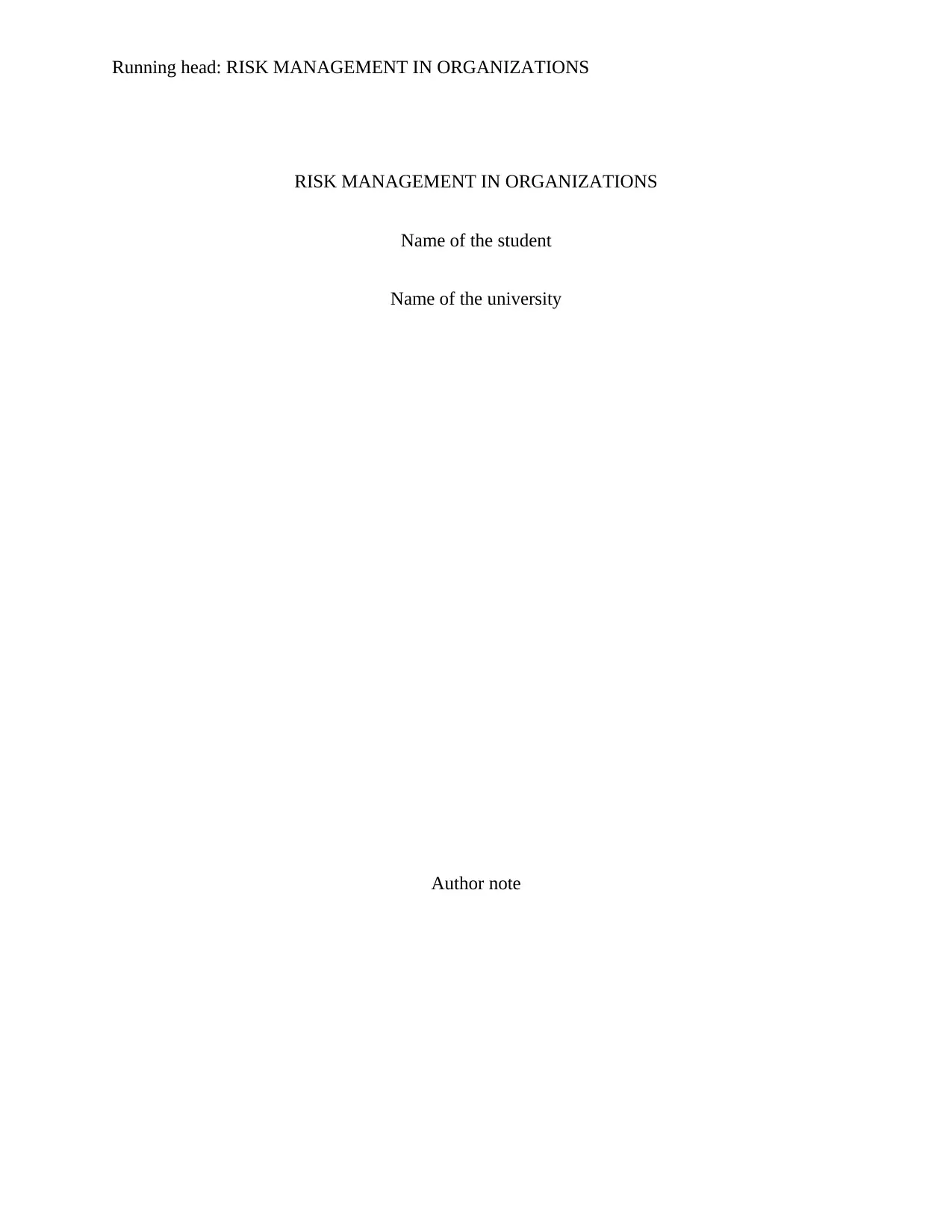
Running head: RISK MANAGEMENT IN ORGANIZATIONS
RISK MANAGEMENT IN ORGANIZATIONS
Name of the student
Name of the university
Author note
RISK MANAGEMENT IN ORGANIZATIONS
Name of the student
Name of the university
Author note
Paraphrase This Document
Need a fresh take? Get an instant paraphrase of this document with our AI Paraphraser
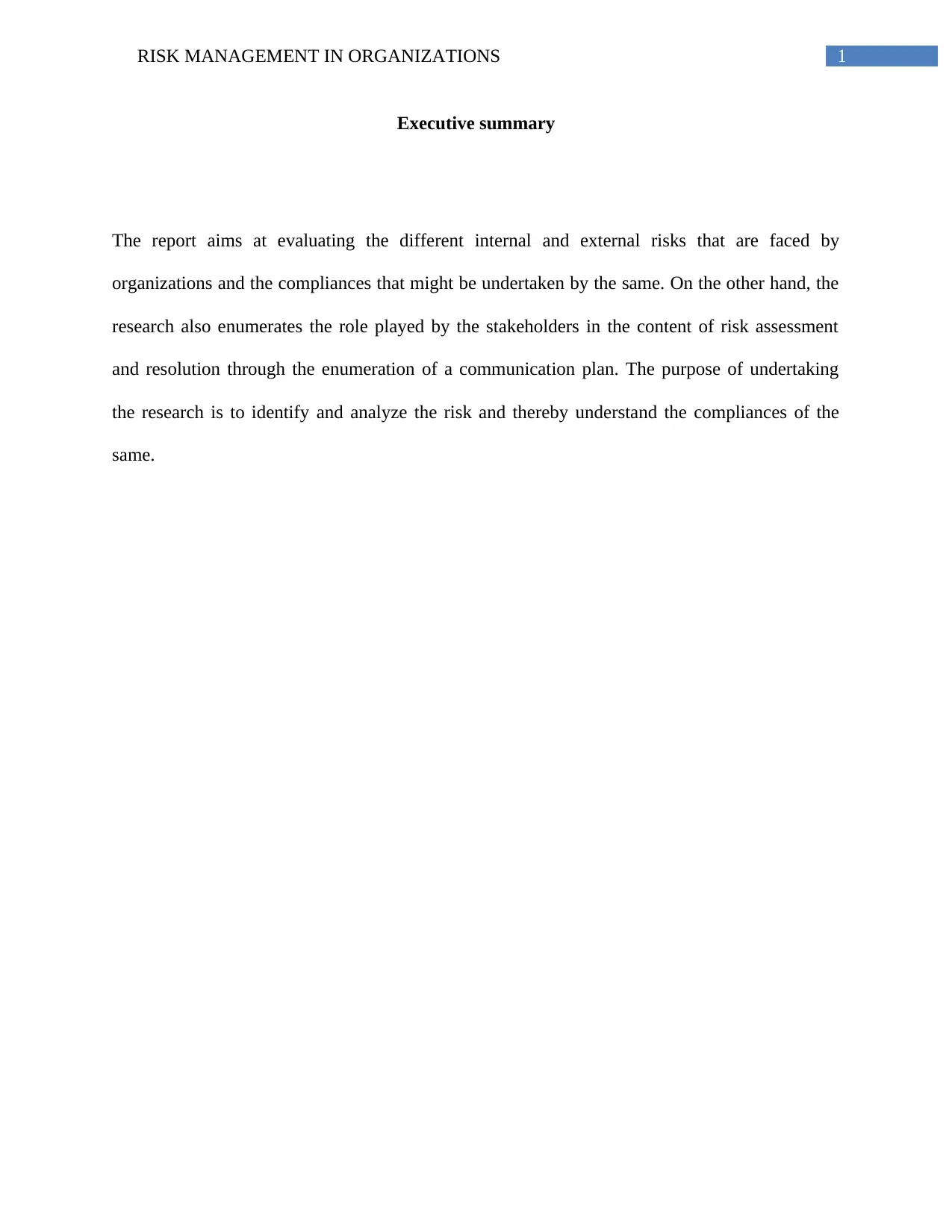
1RISK MANAGEMENT IN ORGANIZATIONS
Executive summary
The report aims at evaluating the different internal and external risks that are faced by
organizations and the compliances that might be undertaken by the same. On the other hand, the
research also enumerates the role played by the stakeholders in the content of risk assessment
and resolution through the enumeration of a communication plan. The purpose of undertaking
the research is to identify and analyze the risk and thereby understand the compliances of the
same.
Executive summary
The report aims at evaluating the different internal and external risks that are faced by
organizations and the compliances that might be undertaken by the same. On the other hand, the
research also enumerates the role played by the stakeholders in the content of risk assessment
and resolution through the enumeration of a communication plan. The purpose of undertaking
the research is to identify and analyze the risk and thereby understand the compliances of the
same.
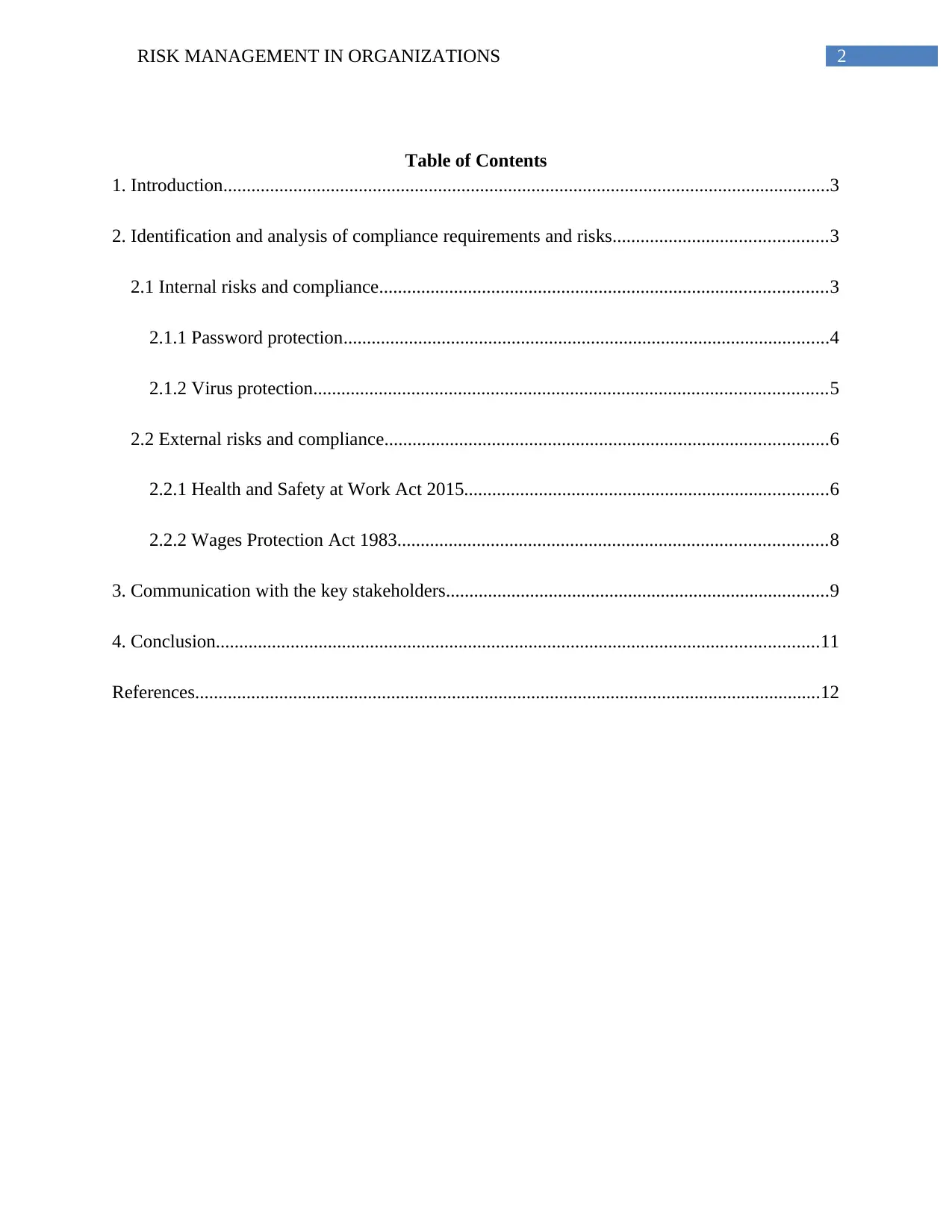
2RISK MANAGEMENT IN ORGANIZATIONS
Table of Contents
1. Introduction..................................................................................................................................3
2. Identification and analysis of compliance requirements and risks..............................................3
2.1 Internal risks and compliance................................................................................................3
2.1.1 Password protection........................................................................................................4
2.1.2 Virus protection..............................................................................................................5
2.2 External risks and compliance...............................................................................................6
2.2.1 Health and Safety at Work Act 2015..............................................................................6
2.2.2 Wages Protection Act 1983............................................................................................8
3. Communication with the key stakeholders..................................................................................9
4. Conclusion.................................................................................................................................11
References......................................................................................................................................12
Table of Contents
1. Introduction..................................................................................................................................3
2. Identification and analysis of compliance requirements and risks..............................................3
2.1 Internal risks and compliance................................................................................................3
2.1.1 Password protection........................................................................................................4
2.1.2 Virus protection..............................................................................................................5
2.2 External risks and compliance...............................................................................................6
2.2.1 Health and Safety at Work Act 2015..............................................................................6
2.2.2 Wages Protection Act 1983............................................................................................8
3. Communication with the key stakeholders..................................................................................9
4. Conclusion.................................................................................................................................11
References......................................................................................................................................12
⊘ This is a preview!⊘
Do you want full access?
Subscribe today to unlock all pages.

Trusted by 1+ million students worldwide
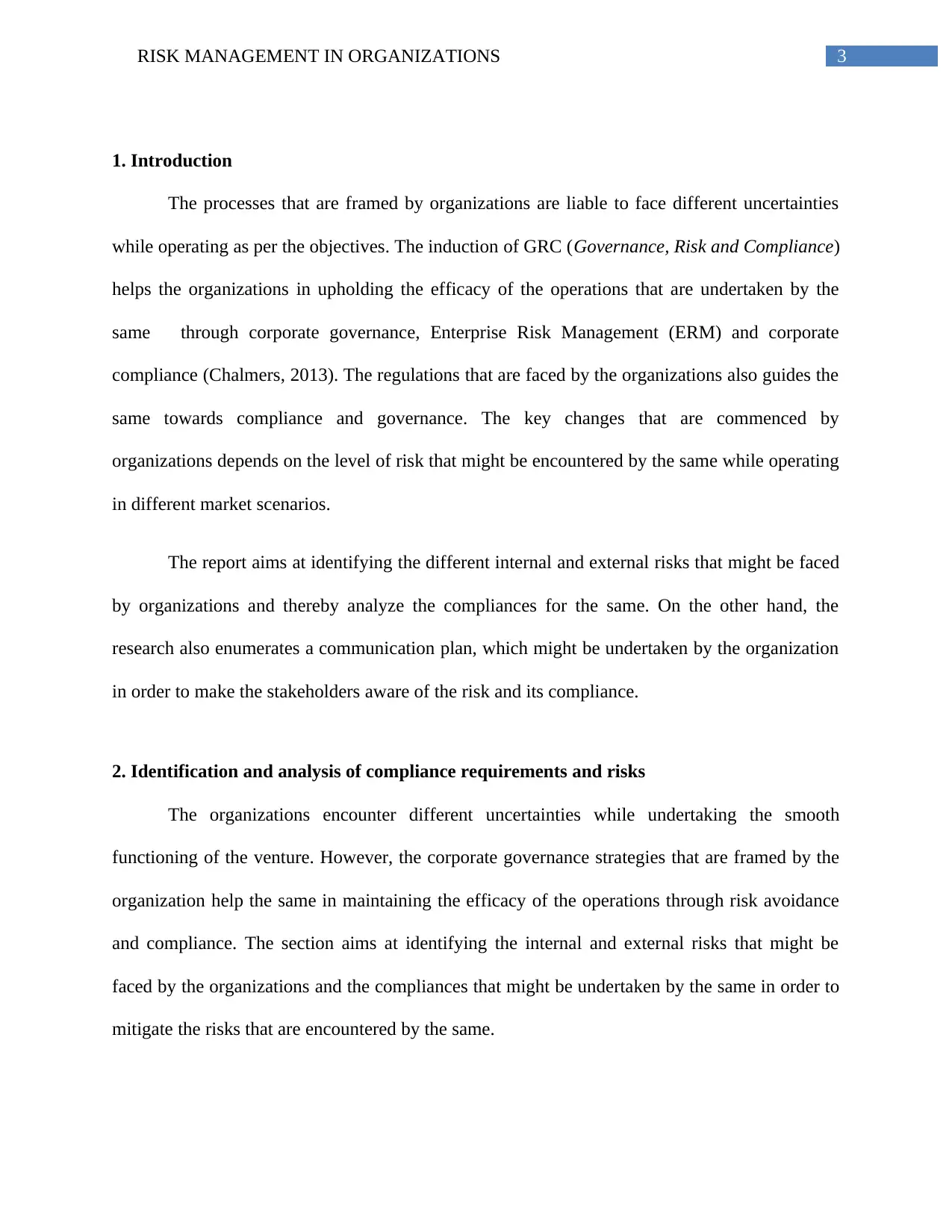
3RISK MANAGEMENT IN ORGANIZATIONS
1. Introduction
The processes that are framed by organizations are liable to face different uncertainties
while operating as per the objectives. The induction of GRC (Governance, Risk and Compliance)
helps the organizations in upholding the efficacy of the operations that are undertaken by the
same through corporate governance, Enterprise Risk Management (ERM) and corporate
compliance (Chalmers, 2013). The regulations that are faced by the organizations also guides the
same towards compliance and governance. The key changes that are commenced by
organizations depends on the level of risk that might be encountered by the same while operating
in different market scenarios.
The report aims at identifying the different internal and external risks that might be faced
by organizations and thereby analyze the compliances for the same. On the other hand, the
research also enumerates a communication plan, which might be undertaken by the organization
in order to make the stakeholders aware of the risk and its compliance.
2. Identification and analysis of compliance requirements and risks
The organizations encounter different uncertainties while undertaking the smooth
functioning of the venture. However, the corporate governance strategies that are framed by the
organization help the same in maintaining the efficacy of the operations through risk avoidance
and compliance. The section aims at identifying the internal and external risks that might be
faced by the organizations and the compliances that might be undertaken by the same in order to
mitigate the risks that are encountered by the same.
1. Introduction
The processes that are framed by organizations are liable to face different uncertainties
while operating as per the objectives. The induction of GRC (Governance, Risk and Compliance)
helps the organizations in upholding the efficacy of the operations that are undertaken by the
same through corporate governance, Enterprise Risk Management (ERM) and corporate
compliance (Chalmers, 2013). The regulations that are faced by the organizations also guides the
same towards compliance and governance. The key changes that are commenced by
organizations depends on the level of risk that might be encountered by the same while operating
in different market scenarios.
The report aims at identifying the different internal and external risks that might be faced
by organizations and thereby analyze the compliances for the same. On the other hand, the
research also enumerates a communication plan, which might be undertaken by the organization
in order to make the stakeholders aware of the risk and its compliance.
2. Identification and analysis of compliance requirements and risks
The organizations encounter different uncertainties while undertaking the smooth
functioning of the venture. However, the corporate governance strategies that are framed by the
organization help the same in maintaining the efficacy of the operations through risk avoidance
and compliance. The section aims at identifying the internal and external risks that might be
faced by the organizations and the compliances that might be undertaken by the same in order to
mitigate the risks that are encountered by the same.
Paraphrase This Document
Need a fresh take? Get an instant paraphrase of this document with our AI Paraphraser
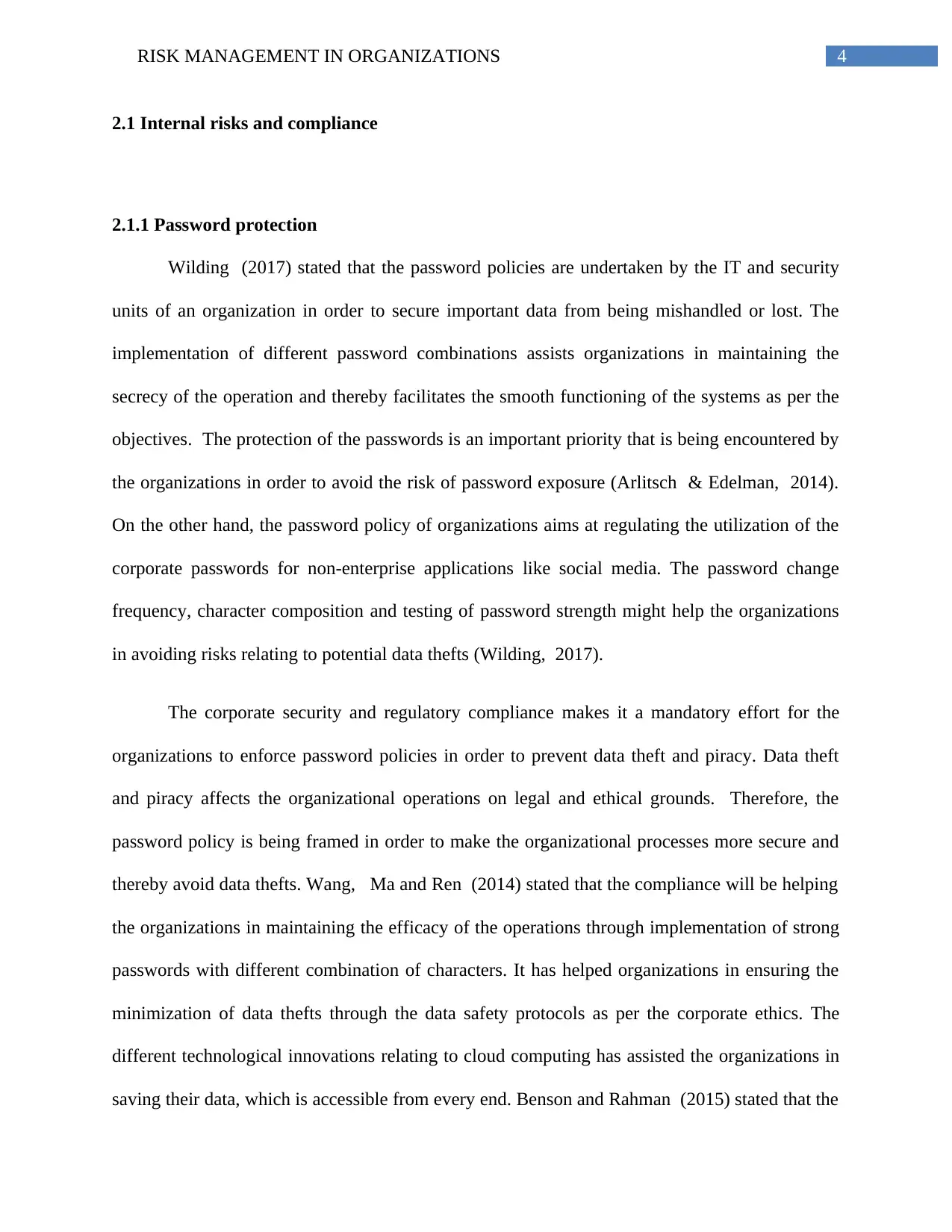
4RISK MANAGEMENT IN ORGANIZATIONS
2.1 Internal risks and compliance
2.1.1 Password protection
Wilding (2017) stated that the password policies are undertaken by the IT and security
units of an organization in order to secure important data from being mishandled or lost. The
implementation of different password combinations assists organizations in maintaining the
secrecy of the operation and thereby facilitates the smooth functioning of the systems as per the
objectives. The protection of the passwords is an important priority that is being encountered by
the organizations in order to avoid the risk of password exposure (Arlitsch & Edelman, 2014).
On the other hand, the password policy of organizations aims at regulating the utilization of the
corporate passwords for non-enterprise applications like social media. The password change
frequency, character composition and testing of password strength might help the organizations
in avoiding risks relating to potential data thefts (Wilding, 2017).
The corporate security and regulatory compliance makes it a mandatory effort for the
organizations to enforce password policies in order to prevent data theft and piracy. Data theft
and piracy affects the organizational operations on legal and ethical grounds. Therefore, the
password policy is being framed in order to make the organizational processes more secure and
thereby avoid data thefts. Wang, Ma and Ren (2014) stated that the compliance will be helping
the organizations in maintaining the efficacy of the operations through implementation of strong
passwords with different combination of characters. It has helped organizations in ensuring the
minimization of data thefts through the data safety protocols as per the corporate ethics. The
different technological innovations relating to cloud computing has assisted the organizations in
saving their data, which is accessible from every end. Benson and Rahman (2015) stated that the
2.1 Internal risks and compliance
2.1.1 Password protection
Wilding (2017) stated that the password policies are undertaken by the IT and security
units of an organization in order to secure important data from being mishandled or lost. The
implementation of different password combinations assists organizations in maintaining the
secrecy of the operation and thereby facilitates the smooth functioning of the systems as per the
objectives. The protection of the passwords is an important priority that is being encountered by
the organizations in order to avoid the risk of password exposure (Arlitsch & Edelman, 2014).
On the other hand, the password policy of organizations aims at regulating the utilization of the
corporate passwords for non-enterprise applications like social media. The password change
frequency, character composition and testing of password strength might help the organizations
in avoiding risks relating to potential data thefts (Wilding, 2017).
The corporate security and regulatory compliance makes it a mandatory effort for the
organizations to enforce password policies in order to prevent data theft and piracy. Data theft
and piracy affects the organizational operations on legal and ethical grounds. Therefore, the
password policy is being framed in order to make the organizational processes more secure and
thereby avoid data thefts. Wang, Ma and Ren (2014) stated that the compliance will be helping
the organizations in maintaining the efficacy of the operations through implementation of strong
passwords with different combination of characters. It has helped organizations in ensuring the
minimization of data thefts through the data safety protocols as per the corporate ethics. The
different technological innovations relating to cloud computing has assisted the organizations in
saving their data, which is accessible from every end. Benson and Rahman (2015) stated that the
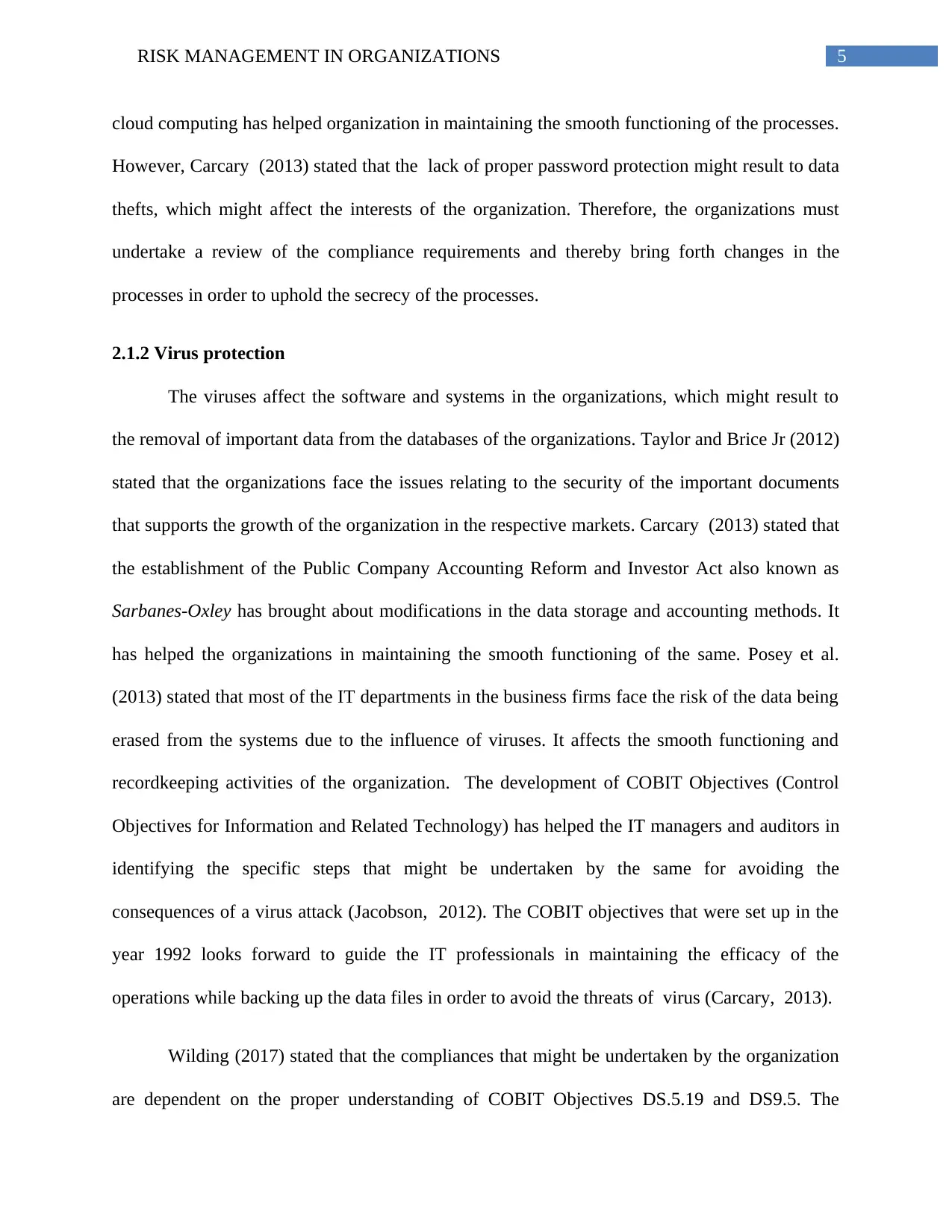
5RISK MANAGEMENT IN ORGANIZATIONS
cloud computing has helped organization in maintaining the smooth functioning of the processes.
However, Carcary (2013) stated that the lack of proper password protection might result to data
thefts, which might affect the interests of the organization. Therefore, the organizations must
undertake a review of the compliance requirements and thereby bring forth changes in the
processes in order to uphold the secrecy of the processes.
2.1.2 Virus protection
The viruses affect the software and systems in the organizations, which might result to
the removal of important data from the databases of the organizations. Taylor and Brice Jr (2012)
stated that the organizations face the issues relating to the security of the important documents
that supports the growth of the organization in the respective markets. Carcary (2013) stated that
the establishment of the Public Company Accounting Reform and Investor Act also known as
Sarbanes-Oxley has brought about modifications in the data storage and accounting methods. It
has helped the organizations in maintaining the smooth functioning of the same. Posey et al.
(2013) stated that most of the IT departments in the business firms face the risk of the data being
erased from the systems due to the influence of viruses. It affects the smooth functioning and
recordkeeping activities of the organization. The development of COBIT Objectives (Control
Objectives for Information and Related Technology) has helped the IT managers and auditors in
identifying the specific steps that might be undertaken by the same for avoiding the
consequences of a virus attack (Jacobson, 2012). The COBIT objectives that were set up in the
year 1992 looks forward to guide the IT professionals in maintaining the efficacy of the
operations while backing up the data files in order to avoid the threats of virus (Carcary, 2013).
Wilding (2017) stated that the compliances that might be undertaken by the organization
are dependent on the proper understanding of COBIT Objectives DS.5.19 and DS9.5. The
cloud computing has helped organization in maintaining the smooth functioning of the processes.
However, Carcary (2013) stated that the lack of proper password protection might result to data
thefts, which might affect the interests of the organization. Therefore, the organizations must
undertake a review of the compliance requirements and thereby bring forth changes in the
processes in order to uphold the secrecy of the processes.
2.1.2 Virus protection
The viruses affect the software and systems in the organizations, which might result to
the removal of important data from the databases of the organizations. Taylor and Brice Jr (2012)
stated that the organizations face the issues relating to the security of the important documents
that supports the growth of the organization in the respective markets. Carcary (2013) stated that
the establishment of the Public Company Accounting Reform and Investor Act also known as
Sarbanes-Oxley has brought about modifications in the data storage and accounting methods. It
has helped the organizations in maintaining the smooth functioning of the same. Posey et al.
(2013) stated that most of the IT departments in the business firms face the risk of the data being
erased from the systems due to the influence of viruses. It affects the smooth functioning and
recordkeeping activities of the organization. The development of COBIT Objectives (Control
Objectives for Information and Related Technology) has helped the IT managers and auditors in
identifying the specific steps that might be undertaken by the same for avoiding the
consequences of a virus attack (Jacobson, 2012). The COBIT objectives that were set up in the
year 1992 looks forward to guide the IT professionals in maintaining the efficacy of the
operations while backing up the data files in order to avoid the threats of virus (Carcary, 2013).
Wilding (2017) stated that the compliances that might be undertaken by the organization
are dependent on the proper understanding of COBIT Objectives DS.5.19 and DS9.5. The
⊘ This is a preview!⊘
Do you want full access?
Subscribe today to unlock all pages.

Trusted by 1+ million students worldwide
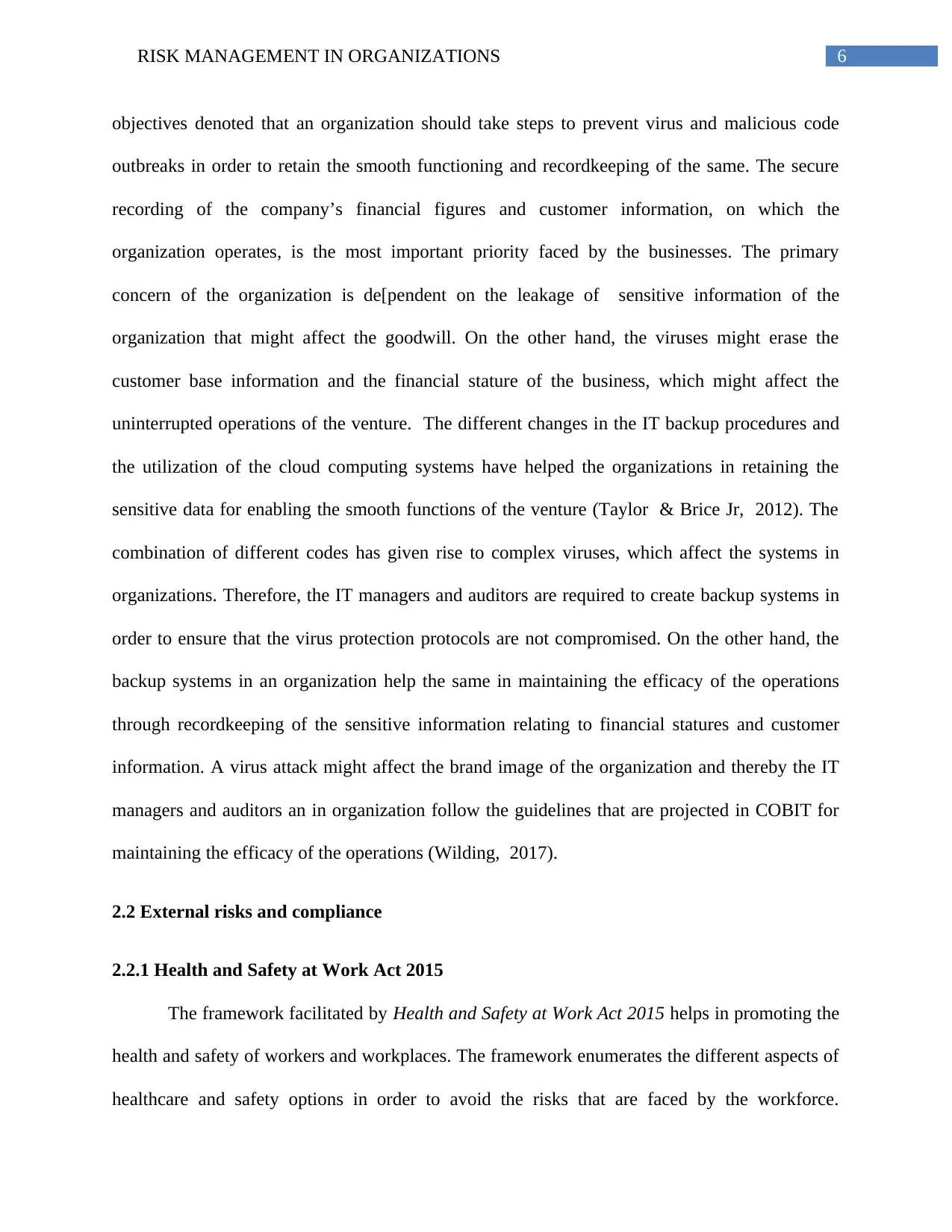
6RISK MANAGEMENT IN ORGANIZATIONS
objectives denoted that an organization should take steps to prevent virus and malicious code
outbreaks in order to retain the smooth functioning and recordkeeping of the same. The secure
recording of the company’s financial figures and customer information, on which the
organization operates, is the most important priority faced by the businesses. The primary
concern of the organization is de[pendent on the leakage of sensitive information of the
organization that might affect the goodwill. On the other hand, the viruses might erase the
customer base information and the financial stature of the business, which might affect the
uninterrupted operations of the venture. The different changes in the IT backup procedures and
the utilization of the cloud computing systems have helped the organizations in retaining the
sensitive data for enabling the smooth functions of the venture (Taylor & Brice Jr, 2012). The
combination of different codes has given rise to complex viruses, which affect the systems in
organizations. Therefore, the IT managers and auditors are required to create backup systems in
order to ensure that the virus protection protocols are not compromised. On the other hand, the
backup systems in an organization help the same in maintaining the efficacy of the operations
through recordkeeping of the sensitive information relating to financial statures and customer
information. A virus attack might affect the brand image of the organization and thereby the IT
managers and auditors an in organization follow the guidelines that are projected in COBIT for
maintaining the efficacy of the operations (Wilding, 2017).
2.2 External risks and compliance
2.2.1 Health and Safety at Work Act 2015
The framework facilitated by Health and Safety at Work Act 2015 helps in promoting the
health and safety of workers and workplaces. The framework enumerates the different aspects of
healthcare and safety options in order to avoid the risks that are faced by the workforce.
objectives denoted that an organization should take steps to prevent virus and malicious code
outbreaks in order to retain the smooth functioning and recordkeeping of the same. The secure
recording of the company’s financial figures and customer information, on which the
organization operates, is the most important priority faced by the businesses. The primary
concern of the organization is de[pendent on the leakage of sensitive information of the
organization that might affect the goodwill. On the other hand, the viruses might erase the
customer base information and the financial stature of the business, which might affect the
uninterrupted operations of the venture. The different changes in the IT backup procedures and
the utilization of the cloud computing systems have helped the organizations in retaining the
sensitive data for enabling the smooth functions of the venture (Taylor & Brice Jr, 2012). The
combination of different codes has given rise to complex viruses, which affect the systems in
organizations. Therefore, the IT managers and auditors are required to create backup systems in
order to ensure that the virus protection protocols are not compromised. On the other hand, the
backup systems in an organization help the same in maintaining the efficacy of the operations
through recordkeeping of the sensitive information relating to financial statures and customer
information. A virus attack might affect the brand image of the organization and thereby the IT
managers and auditors an in organization follow the guidelines that are projected in COBIT for
maintaining the efficacy of the operations (Wilding, 2017).
2.2 External risks and compliance
2.2.1 Health and Safety at Work Act 2015
The framework facilitated by Health and Safety at Work Act 2015 helps in promoting the
health and safety of workers and workplaces. The framework enumerates the different aspects of
healthcare and safety options in order to avoid the risks that are faced by the workforce.
Paraphrase This Document
Need a fresh take? Get an instant paraphrase of this document with our AI Paraphraser
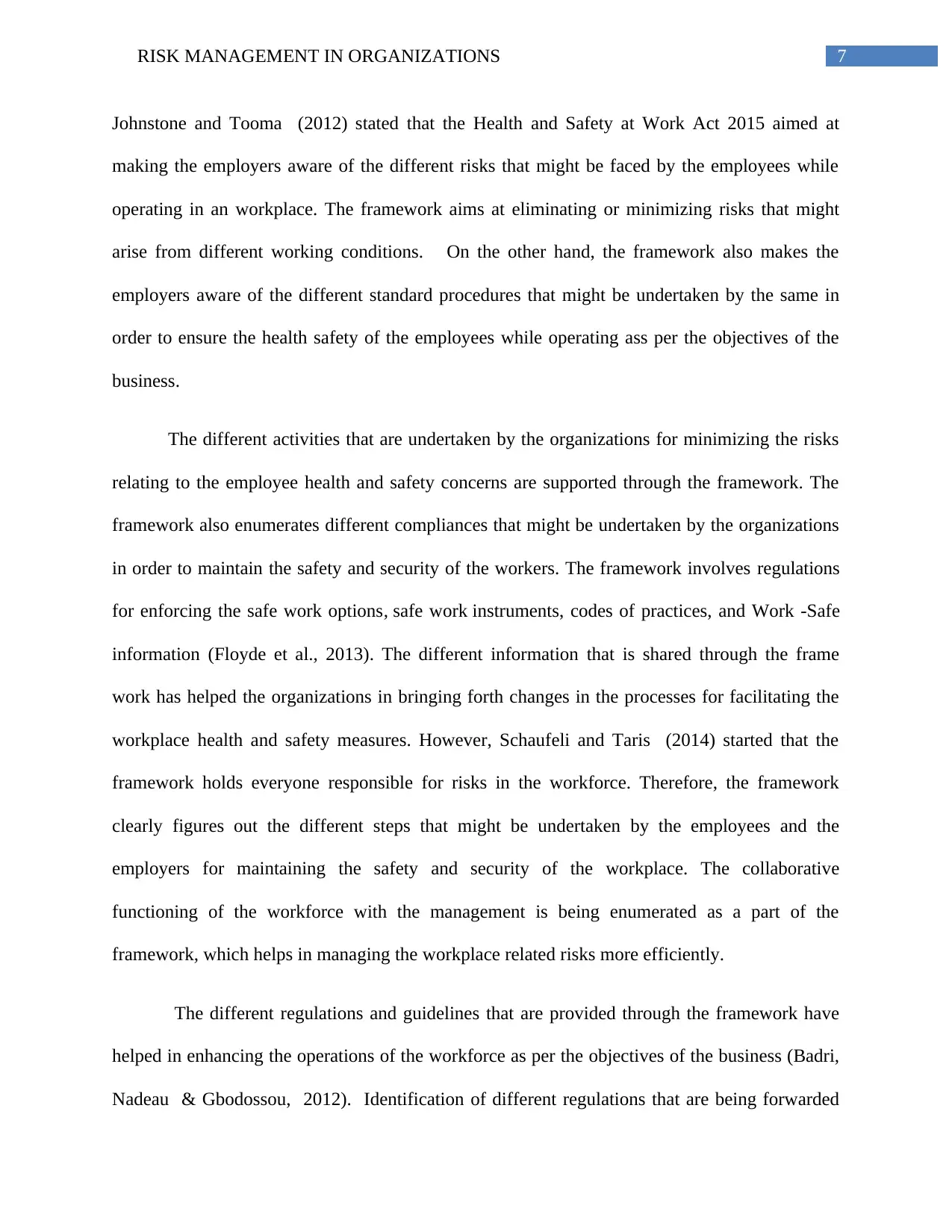
7RISK MANAGEMENT IN ORGANIZATIONS
Johnstone and Tooma (2012) stated that the Health and Safety at Work Act 2015 aimed at
making the employers aware of the different risks that might be faced by the employees while
operating in an workplace. The framework aims at eliminating or minimizing risks that might
arise from different working conditions. On the other hand, the framework also makes the
employers aware of the different standard procedures that might be undertaken by the same in
order to ensure the health safety of the employees while operating ass per the objectives of the
business.
The different activities that are undertaken by the organizations for minimizing the risks
relating to the employee health and safety concerns are supported through the framework. The
framework also enumerates different compliances that might be undertaken by the organizations
in order to maintain the safety and security of the workers. The framework involves regulations
for enforcing the safe work options, safe work instruments, codes of practices, and Work -Safe
information (Floyde et al., 2013). The different information that is shared through the frame
work has helped the organizations in bringing forth changes in the processes for facilitating the
workplace health and safety measures. However, Schaufeli and Taris (2014) started that the
framework holds everyone responsible for risks in the workforce. Therefore, the framework
clearly figures out the different steps that might be undertaken by the employees and the
employers for maintaining the safety and security of the workplace. The collaborative
functioning of the workforce with the management is being enumerated as a part of the
framework, which helps in managing the workplace related risks more efficiently.
The different regulations and guidelines that are provided through the framework have
helped in enhancing the operations of the workforce as per the objectives of the business (Badri,
Nadeau & Gbodossou, 2012). Identification of different regulations that are being forwarded
Johnstone and Tooma (2012) stated that the Health and Safety at Work Act 2015 aimed at
making the employers aware of the different risks that might be faced by the employees while
operating in an workplace. The framework aims at eliminating or minimizing risks that might
arise from different working conditions. On the other hand, the framework also makes the
employers aware of the different standard procedures that might be undertaken by the same in
order to ensure the health safety of the employees while operating ass per the objectives of the
business.
The different activities that are undertaken by the organizations for minimizing the risks
relating to the employee health and safety concerns are supported through the framework. The
framework also enumerates different compliances that might be undertaken by the organizations
in order to maintain the safety and security of the workers. The framework involves regulations
for enforcing the safe work options, safe work instruments, codes of practices, and Work -Safe
information (Floyde et al., 2013). The different information that is shared through the frame
work has helped the organizations in bringing forth changes in the processes for facilitating the
workplace health and safety measures. However, Schaufeli and Taris (2014) started that the
framework holds everyone responsible for risks in the workforce. Therefore, the framework
clearly figures out the different steps that might be undertaken by the employees and the
employers for maintaining the safety and security of the workplace. The collaborative
functioning of the workforce with the management is being enumerated as a part of the
framework, which helps in managing the workplace related risks more efficiently.
The different regulations and guidelines that are provided through the framework have
helped in enhancing the operations of the workforce as per the objectives of the business (Badri,
Nadeau & Gbodossou, 2012). Identification of different regulations that are being forwarded
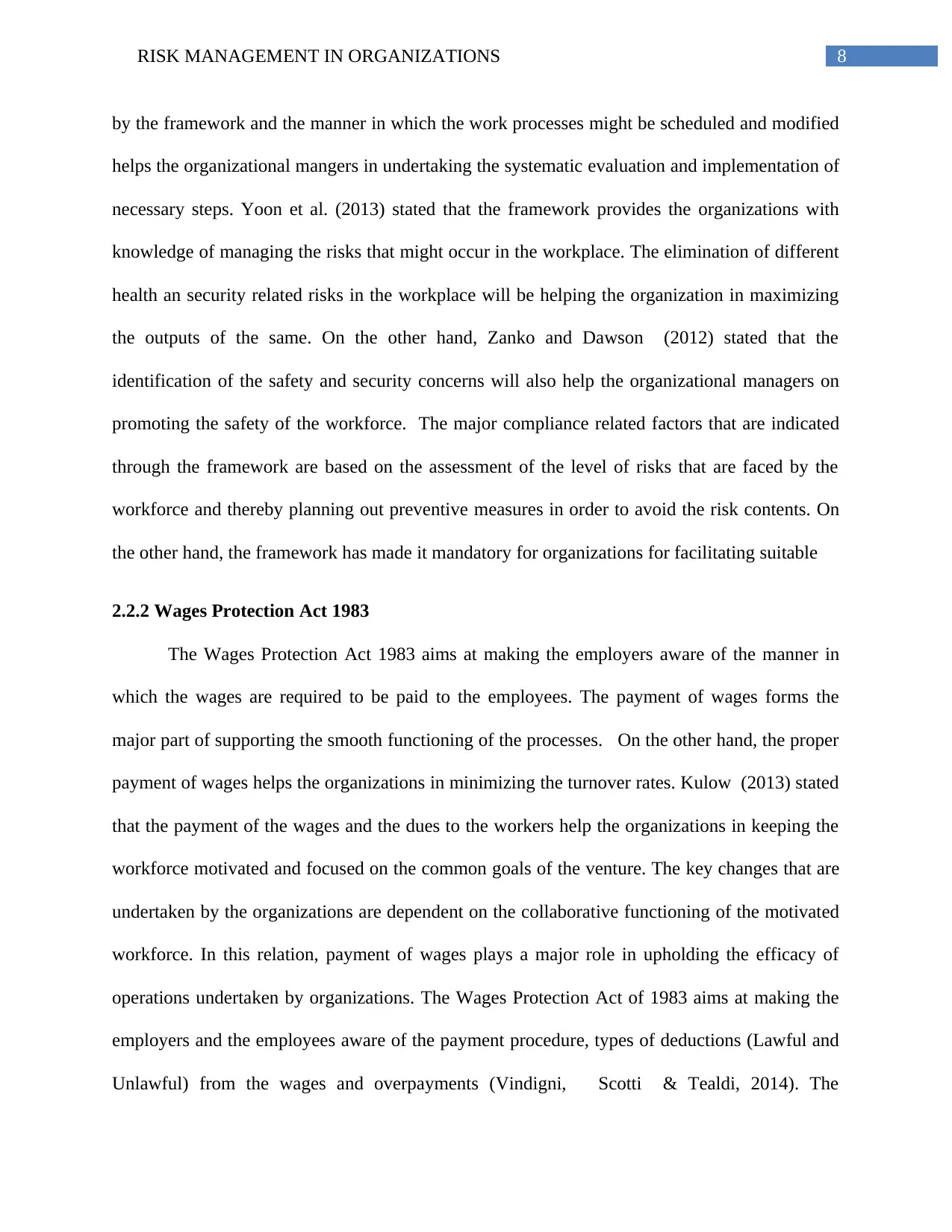
8RISK MANAGEMENT IN ORGANIZATIONS
by the framework and the manner in which the work processes might be scheduled and modified
helps the organizational mangers in undertaking the systematic evaluation and implementation of
necessary steps. Yoon et al. (2013) stated that the framework provides the organizations with
knowledge of managing the risks that might occur in the workplace. The elimination of different
health an security related risks in the workplace will be helping the organization in maximizing
the outputs of the same. On the other hand, Zanko and Dawson (2012) stated that the
identification of the safety and security concerns will also help the organizational managers on
promoting the safety of the workforce. The major compliance related factors that are indicated
through the framework are based on the assessment of the level of risks that are faced by the
workforce and thereby planning out preventive measures in order to avoid the risk contents. On
the other hand, the framework has made it mandatory for organizations for facilitating suitable
2.2.2 Wages Protection Act 1983
The Wages Protection Act 1983 aims at making the employers aware of the manner in
which the wages are required to be paid to the employees. The payment of wages forms the
major part of supporting the smooth functioning of the processes. On the other hand, the proper
payment of wages helps the organizations in minimizing the turnover rates. Kulow (2013) stated
that the payment of the wages and the dues to the workers help the organizations in keeping the
workforce motivated and focused on the common goals of the venture. The key changes that are
undertaken by the organizations are dependent on the collaborative functioning of the motivated
workforce. In this relation, payment of wages plays a major role in upholding the efficacy of
operations undertaken by organizations. The Wages Protection Act of 1983 aims at making the
employers and the employees aware of the payment procedure, types of deductions (Lawful and
Unlawful) from the wages and overpayments (Vindigni, Scotti & Tealdi, 2014). The
by the framework and the manner in which the work processes might be scheduled and modified
helps the organizational mangers in undertaking the systematic evaluation and implementation of
necessary steps. Yoon et al. (2013) stated that the framework provides the organizations with
knowledge of managing the risks that might occur in the workplace. The elimination of different
health an security related risks in the workplace will be helping the organization in maximizing
the outputs of the same. On the other hand, Zanko and Dawson (2012) stated that the
identification of the safety and security concerns will also help the organizational managers on
promoting the safety of the workforce. The major compliance related factors that are indicated
through the framework are based on the assessment of the level of risks that are faced by the
workforce and thereby planning out preventive measures in order to avoid the risk contents. On
the other hand, the framework has made it mandatory for organizations for facilitating suitable
2.2.2 Wages Protection Act 1983
The Wages Protection Act 1983 aims at making the employers aware of the manner in
which the wages are required to be paid to the employees. The payment of wages forms the
major part of supporting the smooth functioning of the processes. On the other hand, the proper
payment of wages helps the organizations in minimizing the turnover rates. Kulow (2013) stated
that the payment of the wages and the dues to the workers help the organizations in keeping the
workforce motivated and focused on the common goals of the venture. The key changes that are
undertaken by the organizations are dependent on the collaborative functioning of the motivated
workforce. In this relation, payment of wages plays a major role in upholding the efficacy of
operations undertaken by organizations. The Wages Protection Act of 1983 aims at making the
employers and the employees aware of the payment procedure, types of deductions (Lawful and
Unlawful) from the wages and overpayments (Vindigni, Scotti & Tealdi, 2014). The
⊘ This is a preview!⊘
Do you want full access?
Subscribe today to unlock all pages.

Trusted by 1+ million students worldwide
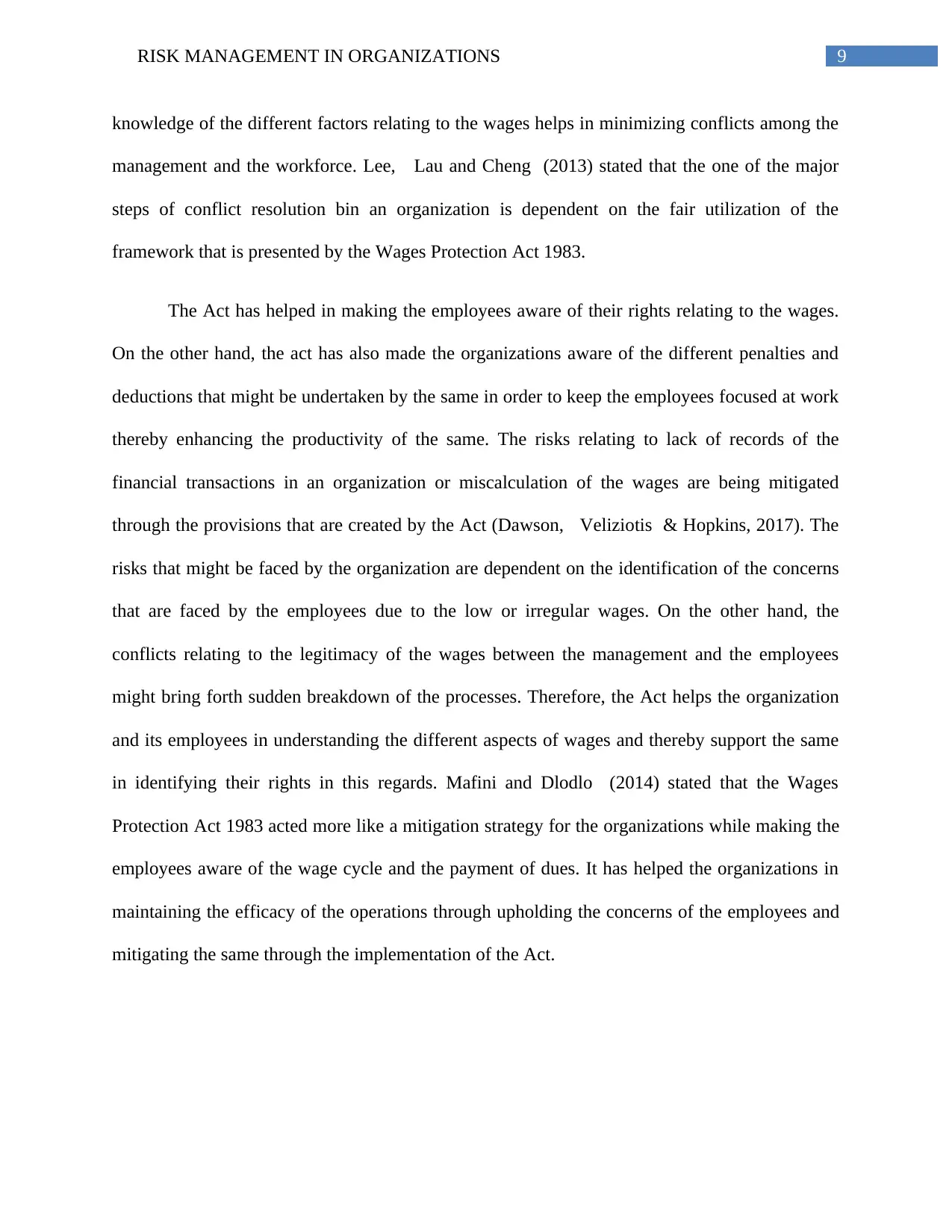
9RISK MANAGEMENT IN ORGANIZATIONS
knowledge of the different factors relating to the wages helps in minimizing conflicts among the
management and the workforce. Lee, Lau and Cheng (2013) stated that the one of the major
steps of conflict resolution bin an organization is dependent on the fair utilization of the
framework that is presented by the Wages Protection Act 1983.
The Act has helped in making the employees aware of their rights relating to the wages.
On the other hand, the act has also made the organizations aware of the different penalties and
deductions that might be undertaken by the same in order to keep the employees focused at work
thereby enhancing the productivity of the same. The risks relating to lack of records of the
financial transactions in an organization or miscalculation of the wages are being mitigated
through the provisions that are created by the Act (Dawson, Veliziotis & Hopkins, 2017). The
risks that might be faced by the organization are dependent on the identification of the concerns
that are faced by the employees due to the low or irregular wages. On the other hand, the
conflicts relating to the legitimacy of the wages between the management and the employees
might bring forth sudden breakdown of the processes. Therefore, the Act helps the organization
and its employees in understanding the different aspects of wages and thereby support the same
in identifying their rights in this regards. Mafini and Dlodlo (2014) stated that the Wages
Protection Act 1983 acted more like a mitigation strategy for the organizations while making the
employees aware of the wage cycle and the payment of dues. It has helped the organizations in
maintaining the efficacy of the operations through upholding the concerns of the employees and
mitigating the same through the implementation of the Act.
knowledge of the different factors relating to the wages helps in minimizing conflicts among the
management and the workforce. Lee, Lau and Cheng (2013) stated that the one of the major
steps of conflict resolution bin an organization is dependent on the fair utilization of the
framework that is presented by the Wages Protection Act 1983.
The Act has helped in making the employees aware of their rights relating to the wages.
On the other hand, the act has also made the organizations aware of the different penalties and
deductions that might be undertaken by the same in order to keep the employees focused at work
thereby enhancing the productivity of the same. The risks relating to lack of records of the
financial transactions in an organization or miscalculation of the wages are being mitigated
through the provisions that are created by the Act (Dawson, Veliziotis & Hopkins, 2017). The
risks that might be faced by the organization are dependent on the identification of the concerns
that are faced by the employees due to the low or irregular wages. On the other hand, the
conflicts relating to the legitimacy of the wages between the management and the employees
might bring forth sudden breakdown of the processes. Therefore, the Act helps the organization
and its employees in understanding the different aspects of wages and thereby support the same
in identifying their rights in this regards. Mafini and Dlodlo (2014) stated that the Wages
Protection Act 1983 acted more like a mitigation strategy for the organizations while making the
employees aware of the wage cycle and the payment of dues. It has helped the organizations in
maintaining the efficacy of the operations through upholding the concerns of the employees and
mitigating the same through the implementation of the Act.
Paraphrase This Document
Need a fresh take? Get an instant paraphrase of this document with our AI Paraphraser
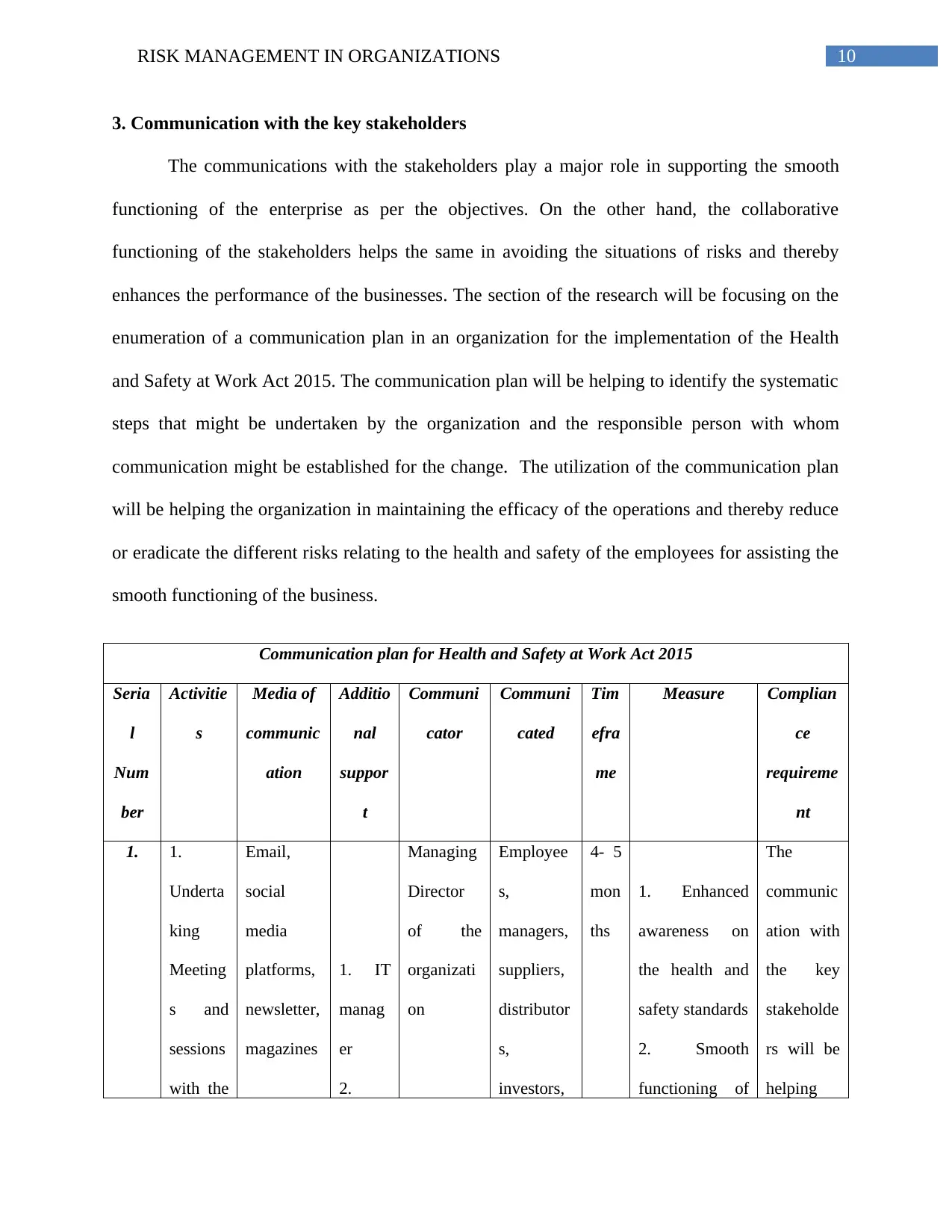
10RISK MANAGEMENT IN ORGANIZATIONS
3. Communication with the key stakeholders
The communications with the stakeholders play a major role in supporting the smooth
functioning of the enterprise as per the objectives. On the other hand, the collaborative
functioning of the stakeholders helps the same in avoiding the situations of risks and thereby
enhances the performance of the businesses. The section of the research will be focusing on the
enumeration of a communication plan in an organization for the implementation of the Health
and Safety at Work Act 2015. The communication plan will be helping to identify the systematic
steps that might be undertaken by the organization and the responsible person with whom
communication might be established for the change. The utilization of the communication plan
will be helping the organization in maintaining the efficacy of the operations and thereby reduce
or eradicate the different risks relating to the health and safety of the employees for assisting the
smooth functioning of the business.
Communication plan for Health and Safety at Work Act 2015
Seria
l
Num
ber
Activitie
s
Media of
communic
ation
Additio
nal
suppor
t
Communi
cator
Communi
cated
Tim
efra
me
Measure Complian
ce
requireme
nt
1. 1.
Underta
king
Meeting
s and
sessions
with the
Email,
social
media
platforms,
newsletter,
magazines
1. IT
manag
er
2.
Managing
Director
of the
organizati
on
Employee
s,
managers,
suppliers,
distributor
s,
investors,
4- 5
mon
ths
1. Enhanced
awareness on
the health and
safety standards
2. Smooth
functioning of
The
communic
ation with
the key
stakeholde
rs will be
helping
3. Communication with the key stakeholders
The communications with the stakeholders play a major role in supporting the smooth
functioning of the enterprise as per the objectives. On the other hand, the collaborative
functioning of the stakeholders helps the same in avoiding the situations of risks and thereby
enhances the performance of the businesses. The section of the research will be focusing on the
enumeration of a communication plan in an organization for the implementation of the Health
and Safety at Work Act 2015. The communication plan will be helping to identify the systematic
steps that might be undertaken by the organization and the responsible person with whom
communication might be established for the change. The utilization of the communication plan
will be helping the organization in maintaining the efficacy of the operations and thereby reduce
or eradicate the different risks relating to the health and safety of the employees for assisting the
smooth functioning of the business.
Communication plan for Health and Safety at Work Act 2015
Seria
l
Num
ber
Activitie
s
Media of
communic
ation
Additio
nal
suppor
t
Communi
cator
Communi
cated
Tim
efra
me
Measure Complian
ce
requireme
nt
1. 1.
Underta
king
Meeting
s and
sessions
with the
Email,
social
media
platforms,
newsletter,
magazines
1. IT
manag
er
2.
Managing
Director
of the
organizati
on
Employee
s,
managers,
suppliers,
distributor
s,
investors,
4- 5
mon
ths
1. Enhanced
awareness on
the health and
safety standards
2. Smooth
functioning of
The
communic
ation with
the key
stakeholde
rs will be
helping
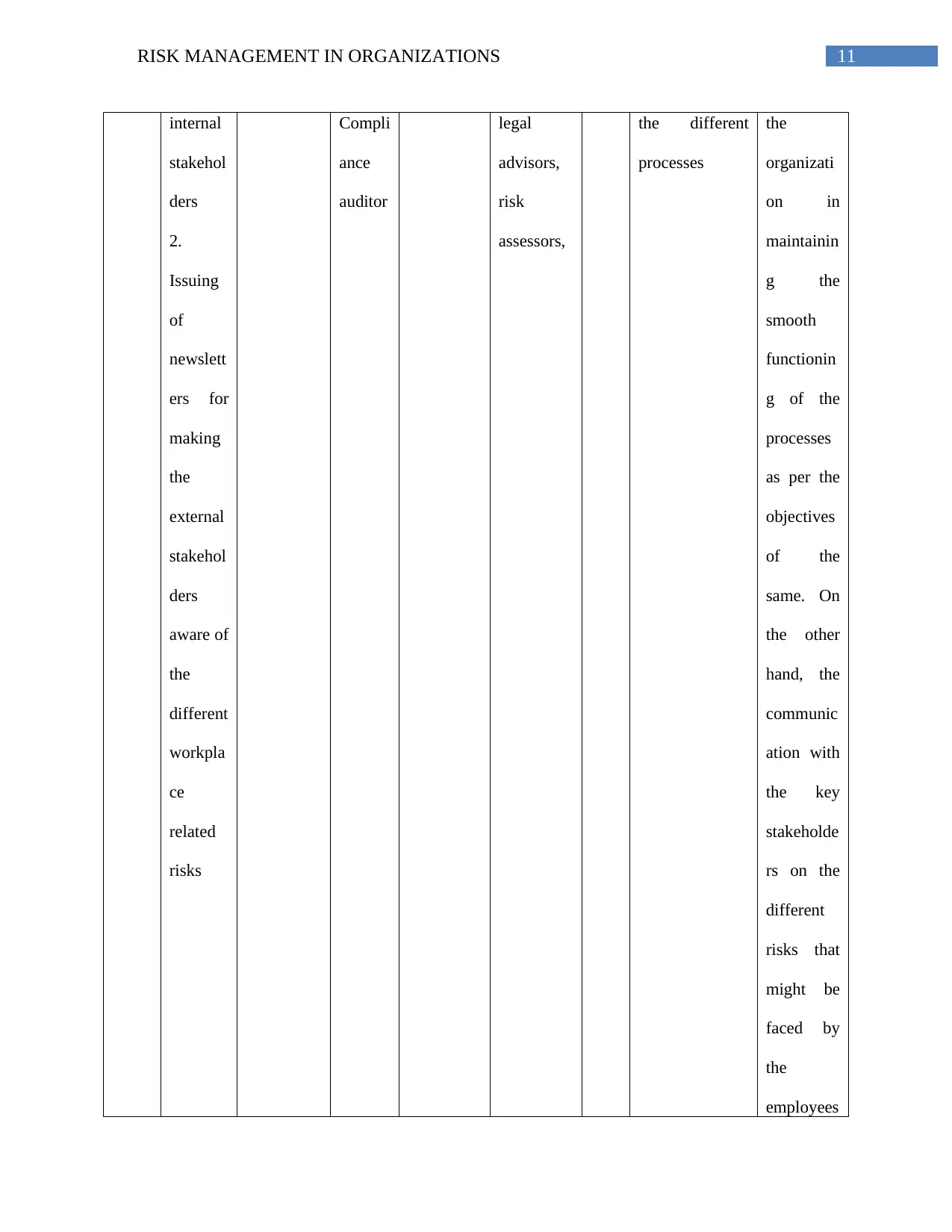
11RISK MANAGEMENT IN ORGANIZATIONS
internal
stakehol
ders
2.
Issuing
of
newslett
ers for
making
the
external
stakehol
ders
aware of
the
different
workpla
ce
related
risks
Compli
ance
auditor
legal
advisors,
risk
assessors,
the different
processes
the
organizati
on in
maintainin
g the
smooth
functionin
g of the
processes
as per the
objectives
of the
same. On
the other
hand, the
communic
ation with
the key
stakeholde
rs on the
different
risks that
might be
faced by
the
employees
internal
stakehol
ders
2.
Issuing
of
newslett
ers for
making
the
external
stakehol
ders
aware of
the
different
workpla
ce
related
risks
Compli
ance
auditor
legal
advisors,
risk
assessors,
the different
processes
the
organizati
on in
maintainin
g the
smooth
functionin
g of the
processes
as per the
objectives
of the
same. On
the other
hand, the
communic
ation with
the key
stakeholde
rs on the
different
risks that
might be
faced by
the
employees
⊘ This is a preview!⊘
Do you want full access?
Subscribe today to unlock all pages.

Trusted by 1+ million students worldwide
1 out of 17
Related Documents
Your All-in-One AI-Powered Toolkit for Academic Success.
+13062052269
info@desklib.com
Available 24*7 on WhatsApp / Email
![[object Object]](/_next/static/media/star-bottom.7253800d.svg)
Unlock your academic potential
Copyright © 2020–2025 A2Z Services. All Rights Reserved. Developed and managed by ZUCOL.




